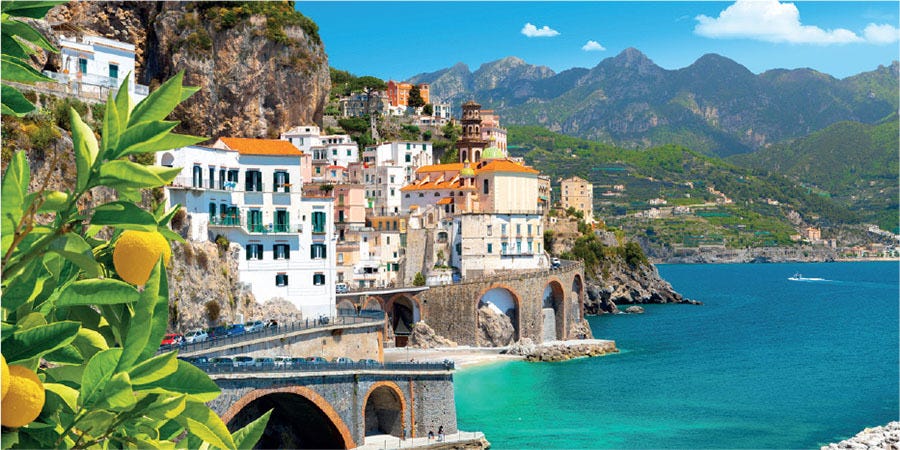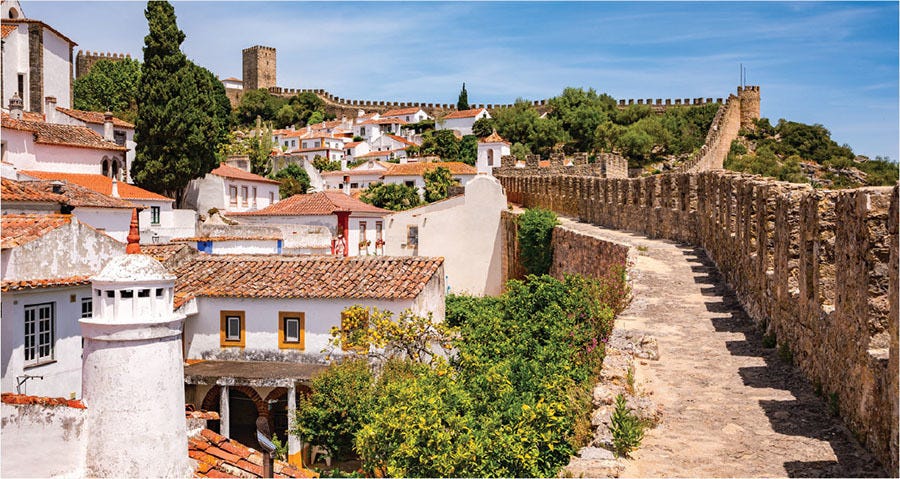Four Globetrotters, Four Unforgettable Moments
From jungle plunges to sunset strolls on medieval walls—these four Globetrotters reveal the beauty of life overseas, one short story at a time.
What do a medieval wall in Portugal, a jungle waterfall in Costa Rica, a helicopter ride over Capri, and a five-million-year-old cave in Mexico have in common?
They’re all real-life experiences, captured in just a few vivid paragraphs, by expats and explorers living their best lives abroad.
In every issue of International Living Magazine, our Globetrotter section offers short, sharp dispatches from people doing just that. Think of them as postcards from a different kind of reality… where the everyday is anything but.
Here are four recent favorites:
Ditch the Traffic. Chopper Your Way to Capri

It doesn’t get much more glamorous than gliding over the Amalfi Coast by helicopter.
This summer, Uber—yes, that Uber—is launching helicopter rides along one of Italy’s most famously congested (and dramatic) coastlines. The route runs from Sorrento to Capri, with ground transfers available from coastal towns like Positano, Ravello, and Amalfi.
Flights are operated by local partners and a seat costs €250 ($286). Each ride includes car service to the helipad in Sorrento—then it’s a scenic flight to Capri over lemon groves, terraced cliffs, and the shimmer of the Tyrrhenian Sea.
No, you won’t be landing on a private helipad at your villa, and no, there’s no prosecco included (yet). But as a way to skip the traffic and arrive in style? It’s hard to beat.
And if flying isn’t your thing, Uber will also offer service for up to 12 people aboard Gozzo 35 motorboats. It’s all so very James Bond.
It’s the kind of luxury shortcut you didn’t know you needed… until it existed.
Booking is simple. Open the Uber app on your smartphone and select the UberCopter icon on the app’s home screen. Choose an available date, pickup, and drop-off location for your trip.
Right now, both services are in testing mode, with limited runs. Reservations open July 25 and must be made at least 48 hours in advance with service only available on Saturday and Sunday between July 26 and August 24.
The chopper experience includes door-to-door transportation to and from the helipad, a 10- to 15-minute flight over the Amalfi Coast, and a return trip later that day. You also have the option of booking a private chopper for up to six people.
Boat departures are from Sorrento Marina at 10:00 a.m., with a maximum capacity of 12 guests per cruise.
—Holly Andrew
Sliding Down Waterfalls in Costa Rica’s Southern Zone

My motto is, "Life’s always better at a waterfall."
Rushing water is soul-soothing, and everyone—from grandparents to children—can enjoy the relaxing and rejuvenating effects of Costa Rica’s Catarata Uvita cascade. You can sunbathe on the rocks, jump off higher points, or float around in the natural pools.
If you’re a waterfall chaser like me, here’s how to take the plunge…
I drove about six hours south from my home in Tamarindo, Guanacaste, to get to Uvita (just under four hours from San Jose). Once I hit the palm-tree-lined La Costanera Sur highway, it was smooth sailing— the road is relaxing and lovely.
To get to the starting point, just plug Restaurante La Catarata into Waze (this driving app is how I always get around Costa Rica). Pay the $4 fee to access the jungle paths and journey into the natural world. As you head to the river, pass through the butterfly garden where bright blue Morphos flutter past your face.
Heading to the waterfall, it’s a mix of easy walking over wooden bridges and slightly slippery terrain over rocks—bring your water shoes. As the river flows, heavy boulders create swimming pools to relax in while listening to the hum of the jungle.
In under 10 minutes, you arrive at the tallest waterfall, where you can climb the secured ladder to the top and slide some 30 feet down the smooth rocks to plunge into the swimming area. Sitting on the top overlooking the falls, my heart was pounding, yet I overcame my fear to experience the thrill.
The cool water is a refreshing change from the heat and humidity, and a sweet, yet slightly musty, earth scent fills the air. Take in the flourishing verdant botanical blanket all around, dotted with bright pink hibiscus and ginger flowers—jungle bathing at its finest.
What to Expect at the Falls
Everyone slides down the waterfall at their own risk and must do so carefully, but there are some tricks to ensure your safety:
Lean back with your hands behind your head to keep your body straight when entering the water.
Be cautious after heavy rain due to stronger currents and possible debris.
Experience the adventure at your comfort level. If you don’t think sliding down the rocks is a good idea, don’t do it. Floating in the pools is awesome too.
You can also jump into the water from a platform down the river.
Tip: If you’d like a guide and cultural insights while adventuring in the area, I recommend booking Henry from the Boruca Indigenous culture.
Medieval Wall Walking in Óbidos, Portugal

"There’s no guardrail!" That was my thought as I stood atop the wall that encircles the town of Óbidos and considered the 42-foot drop.
With one hand solidly anchored to the fortress for balance, I walked the narrow path, admiring the sunset through the crenellations and taking in the Disney-esque village below.
Óbidos, pronounced "OH-bee-dosh," is located an hour north of Lisbon by bus or car and well worth an overnight stay… even if you’re like my husband, who prefers to keep his feet firmly planted on the ground. (He enjoyed listening to a street musician while the rest of us walked the wall.)
Named one of the "Seven Wonders of Portugal," the town served as a military stronghold and Royal Palace for its kings and queens.
Today, you can complete your "medieval experience" with a historic stay. Watch for approaching "invaders" from the 13th-century castle-turned-hotel Pousada Castelo Óbidos or rent a villa fit for nobility.
We opted for the latter at the three-bedroom Casa De Talhada (Stone House), built directly into the craggy hillside, with huge rocks jutting right into the kitchen. It’s steps from the main street (and a café serving Portugal’s famous tarts, pastéis de nata).
And from the rooftop terrace, we could look up and talk to brave wall walkers just a few feet above.
Insider Tips
When in Óbidos, drink Ginjinha! The liqueur is sweet but with a sour cherry flavor achieved by infusing local ginja berries with cinnamon and cloves.
Nearly every shop along the main Rua Direita offers one-euro shots in tiny chocolate cups. (Just be sure to walk along the city’s high walls before sipping Ginjinha, not after.)
After the shops close, warm up with a traditional Portuguese favorite, caldo verde—"green soup" made of creamed kale, chouriço sausage, and potatoes.
If you’re spending the night, be prepared to carry your bags uphill because no vehicles are allowed within the historic city. (We found plenty of free parking just outside the city walls.)
I recommend traveling off-season, even though restaurants and activities may have limited hours. Although the main street can be clogged with tour groups in the hot summer, the crowds were light and temperatures pleasant during our January visit.
Journey to the Depths of a 5-Million-Year-Old Cave

Beneath the sun-dappled jungles of Mexico’s Yucatán Peninsula lies a hidden world of crystalized beauty—where delicate cream- and blush-colored stalactites hang like ancient chandeliers.
Venturing deep inside Akumal’s Aktun Chen Eco Park, a 5-million-year-old cave system in the Riviera Maya, was an ethereal experience. And it was immediately clear why National Geographic ranks the site No. 3 on their Top 10 Underground Walks in the world.
This prehistoric cave is an easy 650-yard walk for any fitness level. Cool and well-ventilated, there’s also a cenote and a boardwalk across an underground river. Almost glacial in clarity, the pristine water of the subterranean stream remains untouched. Swimming is not allowed.
Spotlights showcase underground vaults full of ancient formations and structures. In some places, the stalactites and stalagmites have joined to form colossal columns. In essence, it’s a living museum… so ancient that the Maya say you can hear the spirits of their ancestors.
I opted to take an informative tour offered by the Aktun Chen park service. But the group was excited and loud, shattering the stillness of the space. Were I to return, I would opt for self-guided exploration to better appreciate the peaceful silence of the caves.
Our guide, Carlos, explained that it took hundreds of thousands of years for these icicle-shaped formations to grow. (Stalactites are formed when mineralized rainwater seeps through the limestone ceiling of a cave. The water evaporates and the icicle shape is left. Stalagmites are formed from dripping stalactites, but grow upward from the ground.)
If you book online ahead of time, you’ll receive a 15% discount off the regular $29 admission. Once inside Aktun Eco Park, there’s a free 5-10 minute shuttle to take you through the jungle to reception, where you’ll begin the tour. Set aside the day, because there’s also ziplining and an awe-inspiring cenote—a natural sinkhole filled with water, where you’re allowed to swim.
Want More Moments Like These?
Globetrotters are just one part of what makes International Living Magazine such a joy to read. Each issue brings you fast, fun, and insightful stories from real people living overseas, plus expert guidance, deep-dive destination coverage, and step-by-step strategies for making your own overseas dream a reality.


